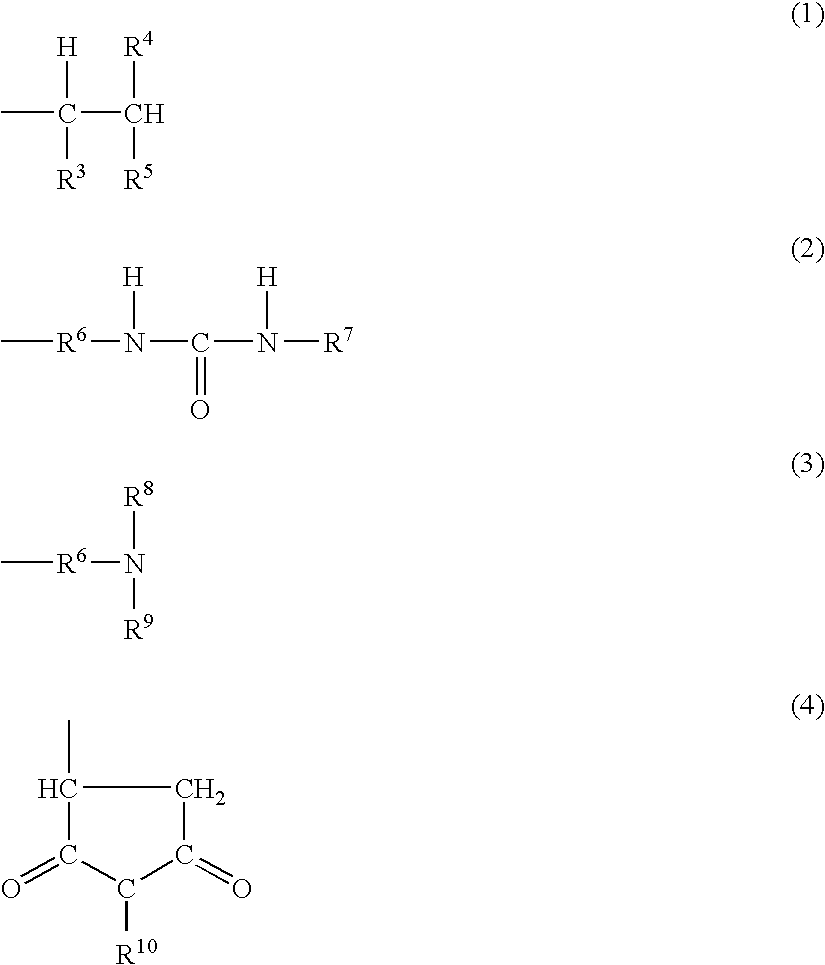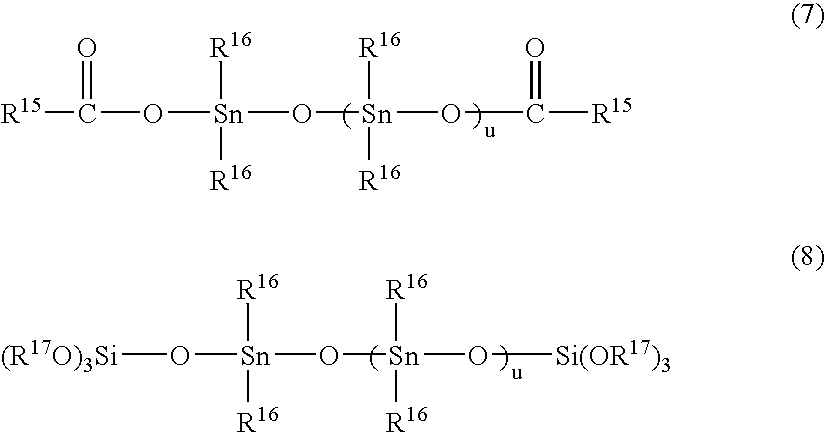Reactive Hot-Melt Resin Composition and Reactive Hot-Melt Adhesive
- Summary
- Abstract
- Description
- Claims
- Application Information
AI Technical Summary
Benefits of technology
Problems solved by technology
Method used
Image
Examples
example 1
PREPARATIVE EXAMPLE 1
[0081]At a ratio of one mole of γ-aminopropyltrimethoxysilane (trade name: KBM903, manufactured by Shin-Etsu Chemical) to one mole of 2-ethylhexyl acrylate, they were mixed and allowed to react with each other at 50° C. for 3 days, to give a product (S-1).
[0082]In a reaction container placed were 500 g of polyolefin polyol (trade name: Polytale HA, manufactured by Mitsubishi Chemical Corp.) and 106 g of isophorone diisocyanate (trade name: Desmodule I, manufactured by Sumika Bayer Urethane), with heat to 90° C. under nitrogen stream, allowed to react for 6 hours, to give a urethane prepolymer (S-2). To this product, 175 g of the product (S-1) obtained above was added, and the mixture was allowed to react at 80° C. for 1 hour, to give a product (S-3).
example 2
PREPARATIVE EXAMPLE 2
[0083]In a reaction container placed were 500 g of polyolefin polyol (trade name: GI-1000, manufactured by Nippon Soda) and 222 g of isophorone diisocyanate (trade name: Desmodule I, manufactured by Sumika Bayer Urethane), allowed to react at 90° C. under nitrogen stream for 6 hours, to give a urethane prepolymer (S-4). To this product, 227 g of N-ethyl-aminoisobutyltrimethoxysilane (trade name: A-link 15, manufactured by Nippon Unicar Co., Ltd.) was added, and the mixture was allowed to react additionally at 80° C. for 1 hour, to give a product (S-5).
PREPARATIVE EXAMPLE 3
[0084]At a ratio of one mole of N-β-(aminoethyl)-γ-aminopropylmethyldimethoxysilane (trade name: KBM602, manufactured by Shin-Etsu Chemical) to 1 mole of lauryl acrylate to 1 mole of methyl acrylate, they were mixed and allowed to react at 50° C. for ten days, to give a product (S-6).
[0085]One mole of dimethyl maleate was added to 1 mole of N-β(aminoethyl)-γ-aminopropyltrimethoxysilane (trade n...
example 3
[0094]The following resin composition (13) was prepared, and the press-bonding period needed for giving an adhesive strength enduring a preset tensile force was determined, according to the following operation. And, it was compared with that of the resin composition (1) obtained in Example 1.
[0095]In a reaction container placed were 500 g of a silane-modified amorphous-poly-α-olefin resin (containing trimethoxysilyl group, trade name: VESTOPLAST 206, manufactured by Degussa Japan) and 500 g of an alicyclic saturated hydrocarbon resin (trade name: Alcon M115, manufactured by Arakawa Kasei Co., Ltd.), with heat to 150° C., allowing dehydration of the resin for 30 minutes, under reduced pressure. To the resins, 0.5 g of boron trifluoride piperidine complex was added, and the mixture was stirred at a temperature of 150° C. for 30 minutes, to give a resin composition (13).
(Determination of Press-Bonding Period)
[0096]The following operation was conducted in an analyzer having a pair of bo...
PUM
| Property | Measurement | Unit |
|---|---|---|
| Percent by mass | aaaaa | aaaaa |
| Percent by mass | aaaaa | aaaaa |
| Percent by mass | aaaaa | aaaaa |
Abstract
Description
Claims
Application Information
 Login to View More
Login to View More - R&D
- Intellectual Property
- Life Sciences
- Materials
- Tech Scout
- Unparalleled Data Quality
- Higher Quality Content
- 60% Fewer Hallucinations
Browse by: Latest US Patents, China's latest patents, Technical Efficacy Thesaurus, Application Domain, Technology Topic, Popular Technical Reports.
© 2025 PatSnap. All rights reserved.Legal|Privacy policy|Modern Slavery Act Transparency Statement|Sitemap|About US| Contact US: help@patsnap.com



